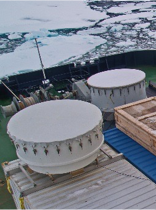- Bolin Centre
- Data
- Oden data repository
- Data from expedition ASCOS, Arctic Ocean, 2008
Millimeter cloud radar Doppler moments measurements from the high-Arctic ASCOS expedition 2008
Matthew Shupe
Cloud information data was collected using a ship-based vertically pointing millimeter cloud radar (MMCR), which is a Doppler radar at the Ka-band, transmitting at 34 GHz. It is very sensitive and ideal for probing low-level clouds. The available variables include the radar reflectivity, the mean Doppler velocity of all hydrometeors and the width of the Doppler spectrum, for each measurement volume as a function of height. Full Doppler spectra is available on request.
Download data
Visit web site
Citation
Matthew Shupe (2018) Millimeter cloud radar Doppler moments measurements from the high-Arctic ASCOS expedition 2008. Dataset version 1. Bolin Centre Database. https://doi.org/10.17043/oden-ascos-2008-cloud-radar-1
References
Tjernström, M. et al. 2014. The Arctic Summer Cloud Ocean Study (ASCOS): overview and experimental design. Atmospheric Chemistry and Physics, 14, 2823–2869. https://doi.org/10.5194/acp-14-2823-2014
Data description
This data set includes measurements from a ground-based, vertically-pointing, Millimeter Cloud Radar (MMCR) which operates at 34-GHz. Data include time-height fields of radar reflectivity, mean Doppler velocity, and Doppler spectrum width, as well as cloud layer base and height as derived from the radar measurements. The MMCR is operated using 4 alternating acquisition modes, each optimized for unique atmospheric conditions. These modes are optimally combined using the ARSCL technique (Clothiaux et al. 2000 JAM) to provide a comprehensive radar measurement data set for the full troposphere. All files are in netCDF format and thus contain data set and field-specific attributes in the files.
This is a large data set; please access the data via:
ftp://ftp1.esrl.noaa.gov/psd3/cruises/ASCOS_2008/ODEN/radar/mmcr/DAMOCLES
Comments
Information on clouds was also collected using surface-based remote sensing from two radars and one microwave radiometer. The main source of information comes from the MilliMeter Cloud Radar (MMCR) which is a vertically pointing Ka-band Doppler radar. The second radar is also a vertically pointing Doppler radar, but at the S-band. The MMCR, transmitting at 34 GHz, is very sensitive and ideal for probing low-level clouds, while the S-band radar is more adapted to measuring precipitation but can also be used for clouds.
Both radars provide three main user products for every measuring volume (determined by the increasing width of the radar beam and the height discrimination): The radar reflectivity; essentially the power of the backscatter of the radar beam; 2) The mean Doppler velocity; the mean vertical speed of all the hydrometeors with respect to the radar, and; 3) The width of the Doppler spectra; all hydrometeors within each volume does not have the same vertical velocity.
In addition to the radars a dual-wavelength radiometer was deployed, observing simultaneously the microwave radiation at two wavelengths, allowing the observation of the vertically integrated water vapor (PWV) and cloud liquid water (LWP).
By a combination of the information from the MMCR, the microwave radiometer, the cloud base ceilometer and the soundings, one can also estimate various cloud microphysics parameter can be estimated.
Original address: http://www.ascos.se/index.php?q=node/260
Images

Image caption
Photo of the cloud remote sensing instruments, showing the S-band radome in the back, the K-band MMCR on top of the radar container, containing all the electronics for both radars and the microwave radiometer at the bottom.
Contact information
Email address
[javascript protected email address]
Phone number
+46 8 16 3110
Postal address
Michael Tjernström
Department of Meteorology
Stockholm University
SE-106 91 Stockholm
Sweden
GCMD science keywords
Earth science > Atmosphere
GCMD location
Ocean > Arctic Ocean
Project
Arctic Summer Cloud-Ocean Study 2008 (Ascos)
Publisher
Bolin Centre Database
DOI
10.17043/oden-ascos-2008-cloud-radar-1
Published
2018-10-16 16:24:39
